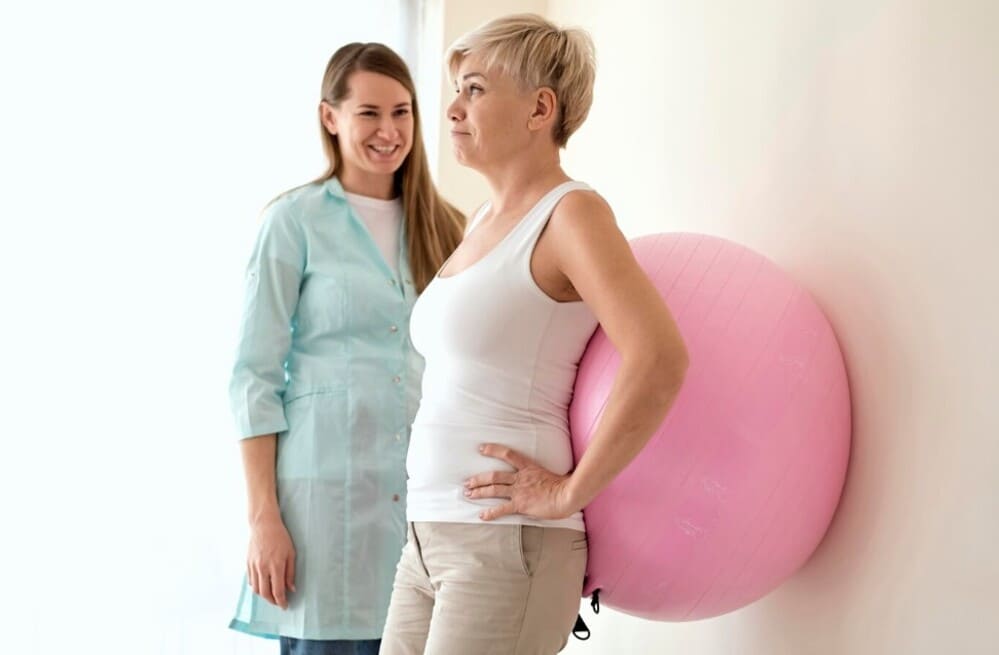What is postpartum physical therapy?
Postpartum physical therapy is a discipline that focuses on treating and preventing physical problems that may arise after childbirth. During pregnancy, a woman’s body undergoes important changes to adapt to the growing baby. These changes can cause alterations in posture, weakening of the abdominal musculature and weakness in the pelvic floor area.
Postpartum physical therapy focuses on helping to restore the function and strength of muscles and tissues that may have been affected during pregnancy and childbirth. This is achieved through a combination of therapeutic exercises, relaxation techniques, stretching and other treatments specific to each woman’s individual needs.
It is important to note that postpartum physical therapy focuses not only on physical recovery, but also on the emotional well-being of the woman. During the postpartum period, it is common for women to experience hormonal changes, fatigue and stress. Postpartum physical therapy can help alleviate these symptoms and promote an overall sense of well-being.
In addition to the physical and emotional benefits, postpartum physical therapy can also have a positive impact on breastfeeding. By improving posture and strengthening chest and back muscles, postpartum physical therapy can help women breastfeed more comfortably and efficiently.

Why is physical therapy necessary after pregnancy?
After giving birth, a woman’s body needs time to recover and heal. During pregnancy, the muscles and tissues of the abdomen and pelvis stretch and weaken, which can result in problems such as back pain, urinary incontinence and sexual dysfunction.
Postpartum physical therapy has been shown to be effective in reducing these problems and promoting a faster and more complete recovery. By strengthening the abdominal and pelvic floor muscles, posture is improved and the risk of long-term injury is reduced. In addition, physical therapy can help relieve stress and muscle tension, promoting an overall sense of well-being.
Objectives of postpartum treatments
Postpartum physical therapy has several main objectives:
- Strengthen the abdominal and pelvic floor muscles.
- Improve posture and body alignment
- Reducing back pain and muscle discomfort
- Preventing urinary incontinence and other problems related to pelvic floor dysfunction
- Improve sexual function
- Promote relaxation and general well-being
Benefits of physical therapy after pregnancy
Postpartum physical therapy offers a number of benefits for women who have given birth:
- Faster recovery: Postpartum physical therapy can speed up the recovery process, allowing women to return to their daily activities more easily.
- Pain reduction: Exercises and techniques used in physical therapy can help reduce back pain and muscle discomfort associated with pregnancy and childbirth.
- Prevention of long-term problems: Strengthening the abdominal and pelvic floor muscles can prevent problems such as urinary incontinence, organ prolapse and sexual dysfunction in the future.
- Improved quality of life: Postpartum physical therapy can help improve posture, sexual function and overall well-being, resulting in a better quality of life for women after childbirth.
Recommended techniques and exercises
There are several techniques and exercises that can be recommended in a postpartum physiotherapy treatment. Some of the most common include:
- Pelvic floor strengthening exercises: These exercises are key to strengthening the muscles that support the bladder, uterus and rectum. Pelvic floor muscle contraction and relaxation exercises, known as Kegel exercises, can be performed.
- Strengthening the abdominal muscles: Exercises such as hypopressive crunches and planks help strengthen the abdominal muscles safely and effectively.
- Relaxation and breathing techniques: These techniques help reduce stress, promote relaxation and improve the mind-body connection.
- Stretching exercises: Stretching is important to maintain flexibility and prevent muscle stiffness.
When is it advisable to start physical therapy at Estudio Aequus?
Postpartum physical therapy can begin as soon as the woman feels comfortable after delivery. However, it is important to keep in mind that every woman is unique and individual needs may vary. In general, it is recommended to wait at least six weeks after delivery to begin physical therapy. This allows the body sufficient time to heal and recover.
At Estudio Aequus, our physiotherapists specialized in postpartum physiotherapy in Mallorca are prepared to assess the individual needs of each woman and provide personalized treatment.
Our comprehensive and personalized approach ensures that women receive the care and attention they need for a healthy and successful recovery.
Your specialist in postpartum physiotherapy

Alvaro Palomino
Registered physiotherapist nº1832
- Physiotherapist graduated from the University of Nebrija.
- Expert in Manual Therapy by the European University of Madrid.
- Degree in Treatment of Mandibular Dysfunctions from the European University of Madrid.
- Qualified in Pilates Method by the University School of Physiotherapy of the ONCE.
- Qualified in Pilates during pregnancy and postpartum, and Hypopressive Exercises by the Spanish Association of Expert Physiotherapists in Pilates.
- Expert in Non Invasive Neuromodulation NESA XSIGNAL.
- Qualified in INDIBA ACTIVE THERAPY.

Caterina
Registered Physiotherapist nº2094
- Graduated in Physiotherapy at the University of the Balearic Islands.
- Master’s Degree in the Integral Approach to the Female and Male Pelvic Floor at the European University of Madrid.
- Certification in Pregnancy and Postpartum Training with OWA.
- Pessary training with Fisinergia.
- Superior Technician in Physical and Sports Activities Animation.
- Training in wood therapy with Silvia López.

